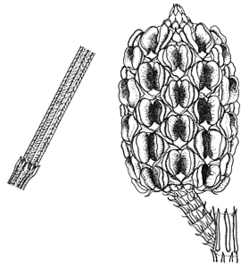Common name: Scrub She-oak
Allocasuarina distyla (Vent.) L.A.S.Johnson APNI* Synonyms: Casuarina distyla Vent. APNI*

Description: Dioecious shrub 1–3 m high.
Branchlets to 35 cm long; articles occasionally waxy, 10–20 mm long, 0.8–1.5 mm diam.; ridges angular to rounded-convex, occasionally sparsely and minutely pubescent; teeth 6–8, erect, slightly overlapping at least when young, occasionally withering, 0.4–1.2 mm long.
Male spikes occasionally moniliform, 1–5-5 (rarely to 9) cm long with 4.5–6.5 whorls of flowers per cm of spike length.
Cones often with sterile apex to 12 mm long, peduncle 2–15 (rarely to 32) mm long; cone body 13–35 (rarely to 50) mm long; bracteoles obtuse to truncate. Samara 4.0–8.0 mm long, very dark brown to black.
Distribution and occurrence: From Port Stephens and Gospers Mtn south to Eden area and the ranges E of Cooma. In tall heath on sandstone hillsides.
NSW subdivisions: NC, CC, SC, CT, ST
Other Australian states: ?Vic.
Hybrids between this species and A. littoralis are relatively common between Broken Bay and Port Hacking.
Text by K. L. Wilson & L. A. S. Johnson (1990); edited KL Wilson (Feb 2014, Jan 2019)
Taxon concept: Flora of NSW 1 (1990)
APNI* Provides a link to the Australian Plant Name Index (hosted by the Australian National Botanic Gardens) for comprehensive bibliographic data
***The AVH map option provides a detailed interactive Australia wide distribution map drawn from collections held by all major Australian herbaria participating in the Australian Virtual Herbarium project.
|


